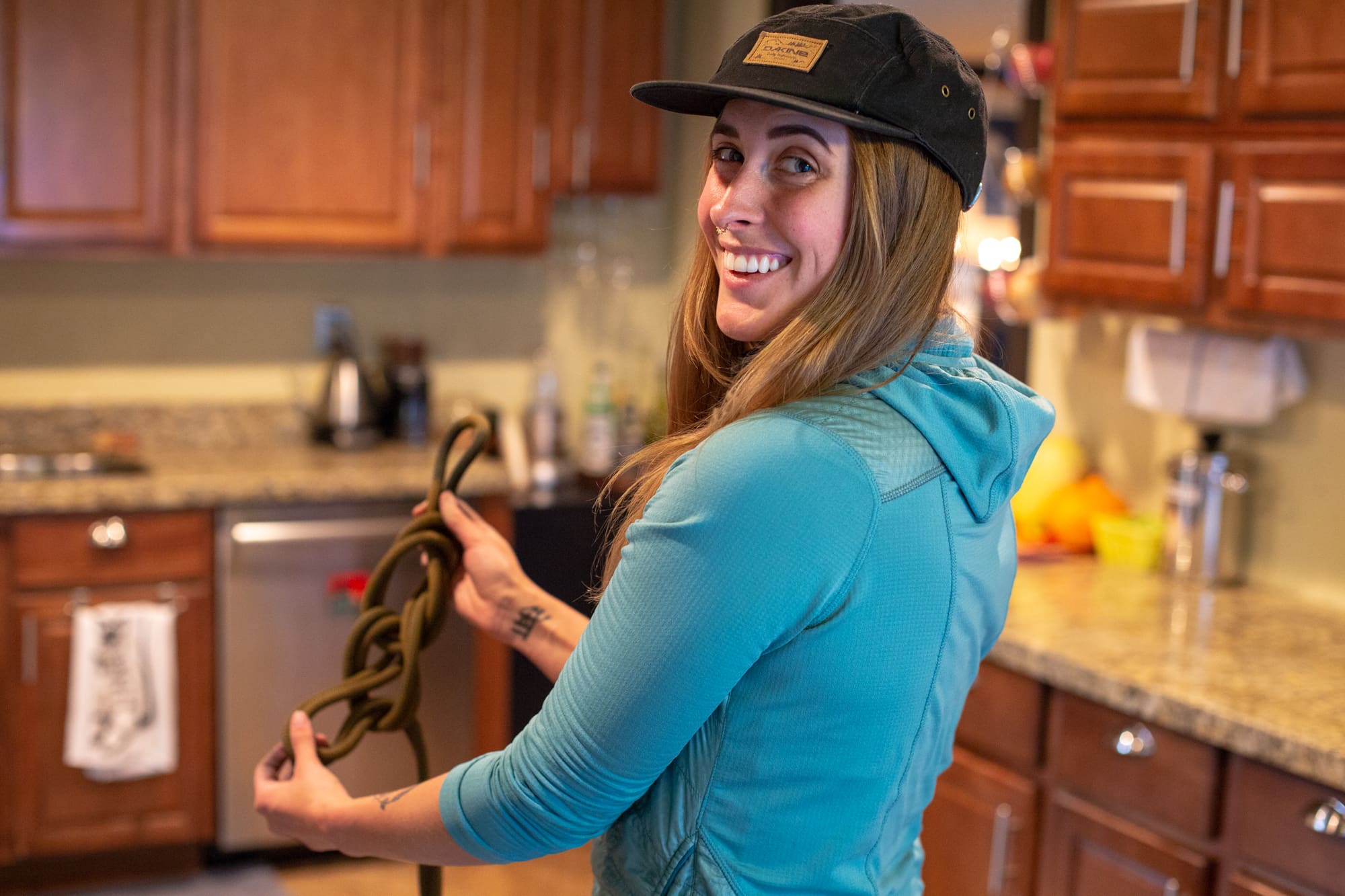Story by Zoe Zulauf Ware / Photos by Jon Vickers /
If it’s the end of the outdoor climbing season and you can’t handle your rope without your palms turning completely grey, it’s probably bathtime. A clean cord belays more smoothly, wears on your climbing gear less, lasts longer, and just looks prettier––but how exactly do you wash a climbing rope?
There are a lot of questions that go along with the process, too. What kind of soap or detergent is safe to use on climbing ropes? Can you really use a washing machine instead of slogging away at your dirty rope in the bathtub? What temperature of water or machine settings should you use? How do you keep the rope from getting tangled in the washer? Can you lay your rope out in the sun to speed up the drying time? A dozen comments on forums will generally give you a dozen different opinions, so I’ve included as much direct information from manufacturers as possible to ensure your beloved rope gets the TLC it deserves.
Prep Your Washer First!
Run your washing machine through a cycle on HOT with nothing in it. If you have a deep water wash setting, utilize it.
Even common household cleaning agents can compromise the integrity of nylon fibers used in climbing gear like ropes, harnesses, and slings. While investigating a spooky harness caper, Black Diamond’s Quality Engineering department found that exposing nylon slings to bleach or Woolite detergent for 30 minutes resulted in a 9% decrease in strength. Sloshing a few rounds of water through your empty machine ensures residue from laundry loads past is rinsed away, leaving you with a nice, clean drum.
As you can never be sure what materials have been washed or which chemicals have been used in a public washing machine, never use an laundromat or shared apartment machine to wash your climbing rope! It’s best to find a friend with a washer or try the bathtub method; your rope and your safety are worth it.
Rope Inspection & Flaking
While your washing machine swishes away, you have the perfect opportunity to inspect your rope from end to end––a practice that should be done routinely during your rope’s lifetime. Flake your rope out to just short of halfway, pull a bit of a loop out to isolate the middle mark, then grab the other end of the rope and flake back towards the center. You end up with two nicely stacked piles of rope, ready to be easily daisy’ed.
Daisy Chain
First, hold the middle mark of the rope and tie an overhand knot on a bight. Then, reach your hand through the bight, grab the two strands of the rope, and pull a loop through. Reach through the loop you just created and pull through another loop. Repeat for 60-70m or until hands fall off. At the very end, I like to pull the tail through for safekeeping. Voila! Admire your handiwork.
If you’re unfamiliar with daisy-chaining, check out this video tutorial!

Load the Washer
If you have a top-loading washer, lower your daisy-chained rope into the drum by circling it nearly all the way around the center, and reversing the direction each time you make a loop––that way, your rope isn’t wrapped around and around and around the center agitator like a boa constrictor.
If you have a front-loading washer, are at all worried about excessive tangling, or have any sharp edges on the agitator, package your rope in an old pillowcase or mesh laundry bag.

Washer Settings
Different rope manufacturers have different opinions on water temperature; Bluewater recommends using only cool or lukewarm water while Sterling suggests washing ropes in warm or hot water, though Tendon specifies water temperatures above 40° C (104° F, the average temperature of a hot tub) can reduce the rope strength and number of falls.
Erring on the side of caution, I think it best to stick with cold to lukewarm water. There’s no harm to be done by washing on the cooler side if you’re concerned about damaging your rope with heat.
One thing all manufacturers agree on is using the slowest, gentlest cycle possible––this is usually the “Delicate” setting on your washer. Any leftover soap residue on your rope will pick up dirt and gunk, so select an extra rinse if possible!
Ropes & Soaps
Now, to the business: what soap is safe to use on climbing ropes? You’ll find a LOT of discussion on climbing sites, and the phrase “mild soap,” or “mild detergent” comes up frequently… But exactly what differentiates soap and detergent or what qualifies it as “mild” isn’t crystal clear.
To keep it simple, soaps are made from fats or oils treated with a strong alkali. They generally leave a film (“soap scum”) by reacting with minerals found in hard water, but are very gentle. Detergents are usually made from synthetic sources and feature a more intensely ionic group at the molecular tail. They’re far more effective as cleaning agents, but can be harsher on the materials they come in contact with.
If we’re talking “mild detergent” in the laundry aisle, Woolite is about as mild as it gets––it’s designed for delicates. But remember that Black Diamond QC test I mentioned? A 30-minute Woolite bath decreased nylon strength by nearly a tenth, and that’s about as scary as 5.10 slab climbing in LCC.
Of course, any laundry detergent would be greatly diluted in a full washing machine, though personally… I’ll take a hard pass on performing any at-home experiments with my rope.
So, my take? Use simple soap in soft water, be a baby with detergents, go with the pros, or go without.
If you have a water softener and don’t want to buy a specialty rope wash, two tablespoons of simple castille soap like Dr. Bronner’s will do just fine. If you don’t have soft water and want to avoid soap scum, use two tablespoons of the mildest, gentlest detergent that exists: baby shampoo. Otherwise, stick with a professional rope wash made by a reputable rope manufacturer (the same brand as your rope, if possible) and follow the directions fastidiously. Aren’t enthused by any of the above? Forego soap/detergent and just wash with lukewarm water––a few rounds of rinsing alone will remove a fair amount of dirt and grit.

Drying
When your cord is done with its deep-cleansing spa treatment, gently pull out the daisy chain and check for soap residue. If you feel any, it’s worth giving the rope another rinse.
Lay out a tarp or clear a section of railing that you can drape the rope over, making sure it’s out of direct sunlight.
Untuck the tail of the rope and start pulling out the daisy chain. Loosely flake out the rope onto a tarp on the ground, or drape the rope over a section of railing, chairs, or any other drying apparatus available. Make sure your drying spot is out of direct sunlight, as UV radiation can weaken ropes over time.
Shuffle around your rope after 10-12 hours to ensure damp spots are exposed to the air. All in all, it should take 24-48 hours to fully dry, depending on the temperature and humidity where you live.
Resolutions
Now, marvel at your refreshed and rejuvenated rope! The color likely won’t ever return to its original vibrancy, but it’ll look a heck of a lot better than before and handle better, too.
It may already be part of your climbing practice, but make a commitment (or renew your resolve) to keep your rope lookin’ spiffy by using a rope bag and/or tarp to keep it off the ground.
So, to recap, here’s the procedure for cleaning your rope.
Quick and Dirty Instructions:
- Run your empty washer through a cycle on hot to remove detergent residue.
- Flake and inspect your climbing rope, then daisy chain from the middle to the ends.
- Load rope into washer, using a mesh bag or pillowcase if you’re worried about abrasion or have a front-loader.
- Select the most delicate cycle possible using only cool to lukewarm water. An extra rinse is great!
- Start the washer, and add rope wash of choice when the drum is full.
- Kick back and relax while your rope gets sudsed.
- When the wash cycle is complete, remove the rope and undo the daisy chain.
- Flake rope out onto a tarp or drape over chairs/railing to dry. Keep out of direct sunlight.
- Shuffle the rope after 10-12 hours to expose any damp spots.
- When the rope is completely dry (usually 24+ hours), bundle it up in a rope bag to keep it sparkling!
What about washing a retired climbing rope?
If you’ve made the responsible call to retire an old dynamic rope and want to get your crafting game on, you don’t need to worry about babying the nylon fibers with gentle soap and lukewarm water. Give ’em what for! Feel free to skip the washing machine prep, wash with hot water, and use a big gob of laundry detergent to really get the grit out. All the other steps stay the same, including using the delicate cycle––you don’t want to end up with a fuzzy, scratched-up rope if you’re weaving a cool floor mat.
Have you tried cleaning your climbing rope in a washing machine? How did it go for you? What other questions do you have about washing ropes? Let us know in the comments!
Climb on, friends.
-Z


